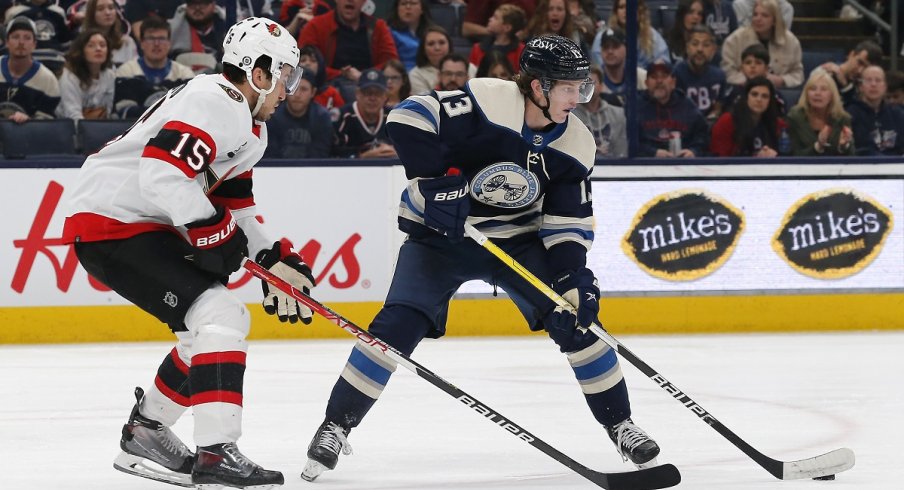On Sunday afternoon, the Columbus Blue Jackets defeated the Edmonton Oilers, 5-2, in a statistically meaningless game. Edmonton has already clinched a playoff berth and is fighting for home ice in the first round. The Blue Jackets, meanwhile, have been mathematically eliminated from playoff contention.
Saying that a game is 'meaningless' comes with negative connotations, though. It wasn't meaningless for Brad Larsen, who is paid to win games. It wasn't meaningless for Elvis Merzlikins, who is trying to find consistency and generate momentum heading into next season. And it definitely wasn't meaningless for Kent Johnson, Cole Sillinger, Yegor Chinakhov, and the other rookies looking to gain a foothold in the NHL.
That's why I feel conflicted about how the ice time was (and has been) divvied by Larsen and the rest of the Columbus coaching staff.
For the first time this season, the aforementioned rookies, all taken in the first round in the past two years of the NHL Draft, played in the lineup at the same time. That's significant. The Blue Jackets have now played 10 (!) rookies this year, which has to be among the most in the NHL. That's a glimpse into the future, something to build upon in a season in which the playoffs aren't in the cards. The next time (the first time?) the Blue Jackets are legitimate Stanley Cup contenders, those players will be a big part of the core.
Alongside Carson Meyer and Justin Danforth, the Blue Jackets skated five rookie forwards out of the 12 total in the lineup in the win over Edmonton. Their ice times were low across the board: Danforth (13:11), Meyer (11:02), Sillinger (10:34), Chinakhov (9:48), and Johnson (8:31) represented five of the six lowest TOIs among forwards (Emil Bemstrom skated 12:28).
This all puts Larsen in an interesting position. On the one hand, it's not in his job description to be equitable with ice time. But it is his job to develop this next wave of players, to put them in a position where they can succeed.
The following blurbs come from directly The Athletic's Aaron Portzline's Sunday Gathering piece, as I think it illustrates this dilemma nicely.
Larsen plans on playing Sillinger and Johnson as much as possible against those great players, he said, giving him an opportunity to see how they fare and giving the players one last look at elite opponents before they hit the offseason.
“It’s going to be trial by fire, and you’re going to have to jump in with both feet,” Larsen said. “The pace of the game is going to be faster, the execution. They’re going to see a higher level of competition. I’m very curious to watch them.
“You’re trying to put them in a position to succeed, but if it’s too much, you pull back. But I have no problem seeing them struggle, either. Maybe they’ll thrive, who knows?”
Yes, who knows? Johnson skated just one shift (22 seconds) in the third period of Sunday's win.
I empathize with Larsen, truly. But I wonder why he and the coaching staff were so opposed to giving Johnson a regular shift (again, the result of this game truly did not matter). Was it to protect him physically? If so, I understand and agree with the decision. Was it to keep him away from Edmonton's top players? Was it so they were in a better position to win the game? If so, I'd push back.
You can't have it both ways. You can't say things like "it's going to be trial by fire" and "I have no problem seeing them struggle" but also say "if it's too much, you pull back."
Which is it? Apparently, it's the latter.
